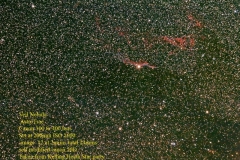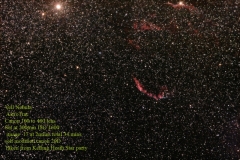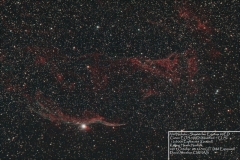[et_pb_section bb_built="1"][et_pb_row][et_pb_column type="4_4"][et_pb_text admin_label="intro Text" _builder_version="3.12"]
The 'Eastern Veil' is part of the Cygnus Loop, other parts of the loop include , the 'Western Veil' or 'Witch's Broom Nebula' (Caldwell 34), and Pickering's Triangular Wisp. It is part of a large, relatively faint supernova remnant in the constellation Cygnus. The source supernova exploded some 5,000 to 8,000 years ago, and the remnants have since expanded to cover an area of ~3x3 degrees. The distance to the nebula is not precisely known, with estimates ranging from 1,400 to 2,600 light-years.
The analysis of the emissions from the nebula indicate the presence of oxygen, sulphur, and hydrogen.
The nebula is notorious among astronomers for being difficult to see visually, even though it has a bright integrated magnitude of 7. However, a telescope using an OIII filter (a filter isolating the wavelength of light from doubly ionized oxygen), will allow an observer to see the nebula clearly, as almost all light from this nebula is emitted at this wavelength. Using an 8-inch (200 mm) telescope equipped with an OIII filter, one could easily see the delicate lacework apparent in photographs. With an OIII filter, almost any telescope could conceivably see this nebula, and some argue that it can be seen without any optical aid, excepting an OIII filter held up to the eye. This is also one of the largest, brightest features in the x-ray sky.
[/et_pb_text][/et_pb_column][/et_pb_row][et_pb_row][et_pb_column type="1_4"][et_pb_text admin_label="JT Image 1" _builder_version="3.12"]

[/et_pb_text][/et_pb_column][et_pb_column type="3_4"][et_pb_text admin_label="Julian Tworek Text" _builder_version="3.12"]
Image by Julian Tworek
Canon 100-400 Lens @200mm ISO 1600 modified Canon 20D Taken at Kelling Heath Star Party
The Eastern Veil is the faint nebula in the top right
[/et_pb_text][/et_pb_column][/et_pb_row][et_pb_row][et_pb_column type="1_4"][et_pb_text _builder_version="3.12"]

[/et_pb_text][/et_pb_column][et_pb_column type="3_4"][et_pb_text admin_label="Julian Tworek 2 Text" _builder_version="3.12"]
Image by Julian Tworek
Canon 100-400 Lens @200mm ISO 1600 modified Canon 20D 17 x 120s Taken at Kelling Heath Star Party
The Eastern Veil is the bright nebula in the middle of the image
[/et_pb_text][/et_pb_column][/et_pb_row][et_pb_row][et_pb_column type="1_4"][et_pb_text admin_label="DS Image" _builder_version="3.12"]

[/et_pb_text][/et_pb_column][et_pb_column type="3_4"][et_pb_text admin_label="David Sheehan Text" _builder_version="3.12"]
Image by David Sheehan
Veil Nebula (The Eastern Veil is in the top right of the image)
Sky Watcher Equinox 80ED
Canon EOS500D (Modified + CLS filter)
Kelling Heath Norfolk
2013-10-05 22:30 (Mid exposure)
[/et_pb_text][/et_pb_column][/et_pb_row][/et_pb_section]







